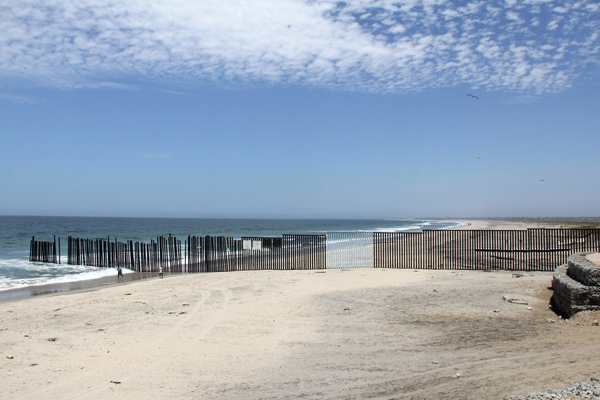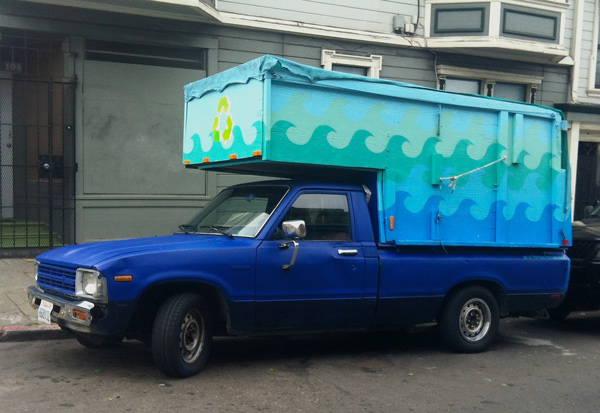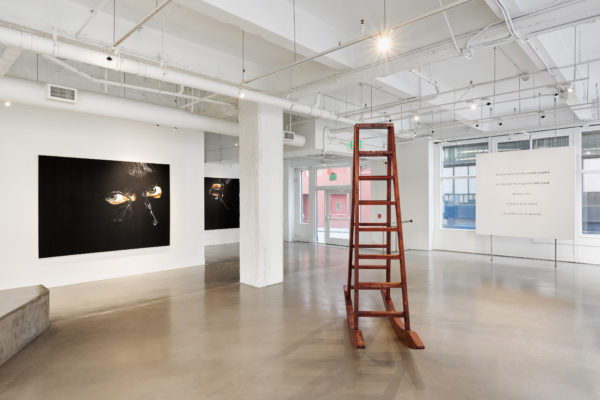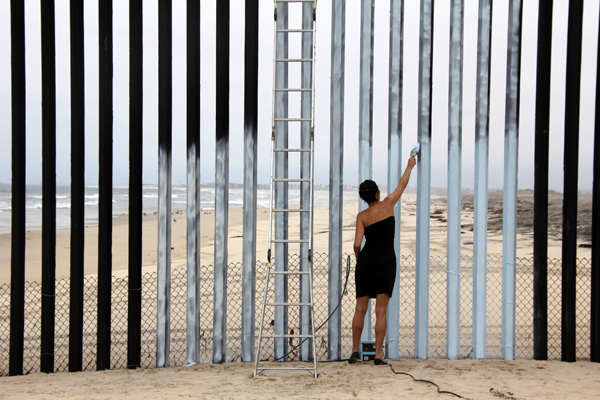Five years ago, San Francisco–based painter, sculptor and performance artist Ana Teresa Fernández woke from a long night’s sleep with a sudden inspiration: She would erase the border fence that divides the United States and Mexico.
It was June, 2011. That October, President Barack Obama would announce the record deportation of nearly 400,000 people. The year before, the U.S. Senate rejected the DREAM Act, and Arizona passed SB 1070, requiring immigrants to carry registration documents.
Fernández stared up at her bedroom ceiling and decided to banish these horrors: She would paint the border fence sky-bright blue, so that it would seem to melt into the empyrean.
“You know how sometimes you wake up with courage?” Fernández recently mused in a phone interview. “I thought, I’m a painter. Why don’t I just paint it out?”

Ana Teresa Fernandez, Erasing the Border (Borrando la Frontera), 2012
Twenty-four hours after her epiphany, Fernández, her mother Maria, and a videographer traveled to the San Diego–Tijuana border armed with periwinkle house paint and a ladder. Fernández had long been making work about Mexican identity and gender, often painting herself performing household chores while dressed up in a black cocktail gown and sexy heels. She wore such attire as she climbed to the tops of the border fence’s long steel pickets, and began to daub them light blue. Within minutes, a police truck screeched up. Two officers jumped out of the vehicle and told her to stop.
“I climb down, and they’re almost going to arrest me,” she recalled; “and we get into this whole debate. But I think that because I was wearing the dress they couldn’t identify me as a hoodlum. I realized that I had an entry point of conversation [with them]. In about 45 minutes, their minds started to decipher it. I said, ‘Let me just finish what I started.’ They said ‘okay,’ and five hours later I’d painted the whole thing out.”

Ana Teresa Fernandez, Erasing the Border (Borrando la Frontera), 2012
Fernández documented the work, Borrando la Frontera (Erasing the Border), by her signature move: She does not just photograph or videotape her performances, but also makes hyperreal and massive paintings of them. Her video and these vibrant oils became sought-after relics of what is now surely Fernández’ most celebrated piece—with the election of President Donald Trump and his continuous calls for “The Wall,” Borrando has grown into an immigration-rights talking point.
Famously, Trump has signed an executive order that clears the way for the building of an “impenetrable, physical, tall, powerful, beautiful” concrete, 55-foot, 200 to 2,000-mile-long Southern border wall that Mexico “will [eventually?] pay” for. He also signed orders that would withhold federal grant funding from sanctuary cities and that further ease the deportation of undocumented immigrants. Trump has pursued his anti-immigration goals with such zeal that he not only sent shockwaves through our culture, but also threatens international relations. Mexican President Enrique Peña Nieto canceled a meeting with Trump on January 26, explaining that Mexico would not pay for the barricade.
These dramas have added to Borrando’s meanings: When asked about the immense amount of attention this one performance receives, Fernández allowed that it is being read as resistance to Trump-style nationalism and racism: “It lets people see what we should be striving for.”
This yearning for a Mexican-American rapprochement percolates through all of Fernández’ art. A dark-haired woman of elegant bearing, Fernández was born in Tampico, Mexico, in 1981. She began to traverse the border at the age of 11 when her physician father, Genaro, commenced a career in San Diego. Her mother, Maria Teresa, taught her to pay close attention to the people who had “risked their lives and become separated from their families.” Fernández developed a “complicated awareness… of what that border stood for—all of this division, all of this sadness.”
Since studying at the San Francisco Art Institute in the early aughts, Fernández has honored her mother’s lessons by creating a body of work that recognizes immigrants’ dignity and insists on their rights. She does this by dematerializing objects as well as making Mexicans as visible as possible.

Erasure 4 (performance documentation), 2015, oil on canvas
Vanishing acts, like Borrando, include 2016’s Erasure. This performance eulogizes the 2014 disappearance of 43 young male student-activists in Ayotzinapa, Mexico, who were presumably murdered. Fernández painted her body black in a slow, complex fade, leaving unmarked only shards of skin around her eyes and mouth. “I wondered, how can these [students] be erased that quickly? Even though I was on this side, I wanted to unify in protest with people who are in Mexico.” Fernández’ personal eclipse obliterated borders just as Borrando did: The work narrates how, through the forces of news, memory and shared grief, what happens “there” also happens “on this side.”
Fernández’ other gift is for the big reveal. In 2008, she memorialized the orphans of the Juarez femicide: Since 1993, the bodies of hundreds of raped and murdered women have been found in the desert, victims of organized crime and government corruption. Fernández worked with three young girls, who modeled for sculptures made in translucent resin. Fernández covered the forms with shards of glass. She crafted the waifs and protected them with dangerous spikes so that people would witness that these “orphans are exposed and vulnerable.” She titled the series “ECDESIS,” after the scientific term for the shedding of skin or protective armor.

TROKA TROKA, 2012, public art project, San Francisco, CA
2010 saw Fernández chasing down San Francisco’s community of trucks carrying stacks of recyclable cardboard. Fernández persuaded four immigrant drivers to redesign their pickups’ exteriors. One vehicle shimmers with blue-green waves; another brandishes orange-green Mondrian color-blocking. With Troka Troka, Fernández helped make the conveyances more conspicuous so that observers could see “that this type of job is so important in our community—it is the ecological flora and fauna of the city.”

Ana Teresa Fernandez, Espina, 2016
Fernández’ work creates an ethos of transnational humanism that demands liberation, mutuality, compassion and respect. She creates hope that, in an age of rising fear and hate, people might look upon her art and “decipher” it, as did the police when she painted Borrando.
“I’m showing what’s happening in Mexico to bring a sense of awareness and empathy,” she insisted on the phone in a clear, calm voice, when asked about her own work’s border crossings. “We’re all interconnected. Political policy doesn’t just stay in the U.S. Our actions here affect people on the other side.”
All images courtesy of the artist and Gallery Wendi Norris, San Francisco.


